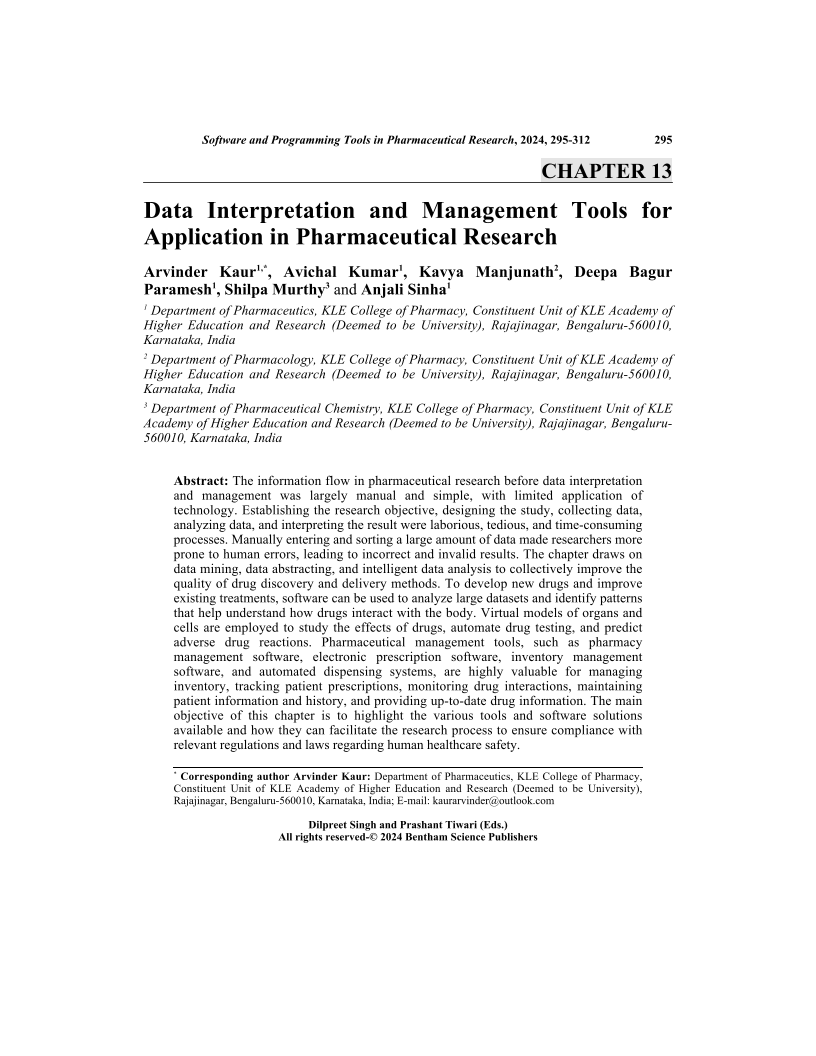Data Interpretation and Management Tools for Application in Pharmaceutical Research

- Authors: Arvinder Kaur1, Avichal Kumar2, Kavya Manjunath3, Deepa Bagur Paramesh4, Shilpa Murthy5, Anjali Sinha6
-
View Affiliations Hide AffiliationsAffiliations: 1 Department of Pharmaceutics, KLE College of Pharmacy, Constituent Unit of KLE Academy of Higher Education and Research (Deemed to be University), Rajajinagar, Bengaluru 560010, Karnataka, India 2 Department of Pharmaceutics, KLE College of Pharmacy, Constituent Unit of KLE Academy of Higher Education and Research (Deemed to be University), Rajajinagar, Bengaluru-560010, Karnataka, India 3 Department of Pharmacology, KLE College of Pharmacy, Constituent Unit of KLE Academy of Higher Education and Research (Deemed to be University), Rajajinagar, Bengaluru-560010, Karnataka, India 4 Department of Pharmaceutics, KLE College of Pharmacy, Constituent Unit of KLE Academy of Higher Education and Research (Deemed to be University), Rajajinagar, Bengaluru-560010, Karnataka, India 5 Department of Pharmaceutical Chemistry, KLE College of Pharmacy, Constituent Unit of KLE Academy of Higher Education and Research (Deemed to be University), Rajajinagar, Bengaluru 560010, Karnataka, India 6 Department of Pharmaceutics, KLE College of Pharmacy, Constituent Unit of KLE Academy of Higher Education and Research (Deemed to be University), Rajajinagar, Bengaluru-560010, Karnataka, India
- Source: Software and Programming Tools in Pharmaceutical Research , pp 295-312
- Publication Date: March 2024
- Language: English
Data Interpretation and Management Tools for Application in Pharmaceutical Research, Page 1 of 1
< Previous page | Next page > /docserver/preview/fulltext/9789815223019/chapter-13-1.gif
The information flow in pharmaceutical research before data interpretation and management was largely manual and simple, with limited application of technology. Establishing the research objective, designing the study, collecting data, analyzing data, and interpreting the result were laborious, tedious, and time-consuming processes. Manually entering and sorting a large amount of data made researchers more prone to human errors, leading to incorrect and invalid results. The chapter draws on data mining, data abstracting, and intelligent data analysis to collectively improve the quality of drug discovery and delivery methods. To develop new drugs and improve existing treatments, software can be used to analyze large datasets and identify patterns that help understand how drugs interact with the body. Virtual models of organs and cells are employed to study the effects of drugs, automate drug testing, and predict adverse drug reactions. Pharmaceutical management tools, such as pharmacy management software, electronic prescription software, inventory management software, and automated dispensing systems, are highly valuable for managing inventory, tracking patient prescriptions, monitoring drug interactions, maintaining patient information and history, and providing up-to-date drug information. The main objective of this chapter is to highlight the various tools and software solutions available and how they can facilitate the research process to ensure compliance with relevant regulations and laws regarding human healthcare safety.
-
From This Site
/content/books/9789815223019.chapter-13dcterms_subject,pub_keyword-contentType:Journal105

